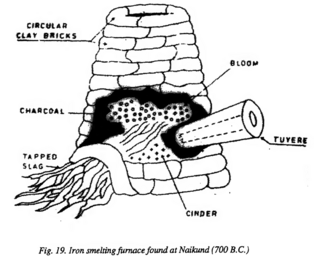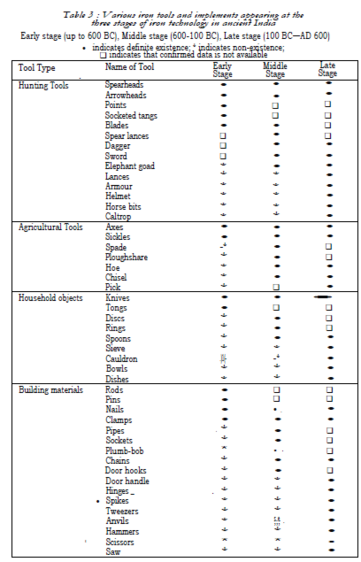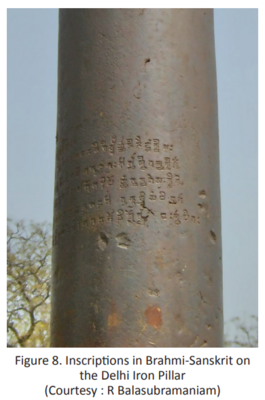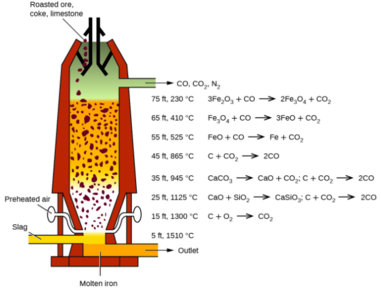Iron or Ayas (अयस्)
| This article needs editing.
Add and improvise the content from reliable sources. |
Iron, called as Ayas (Samskrit: अयस्) heralded a new era in the history of mankind. Iron technology has a special place among the ancient technologies that accelerated the pace of progress and brought prosperity in society. In human history Iron Age succeeded Copper-Bronze Age as iron required a different kind of skill and a higher level of metallurgical expertise. The craftsmen who were adept in working with copper and its alloys and other glittering metals like gold, silver etc., that could be used in their native form at a much lower temperature could not smelt iron with the same technique. India has rich iron ore deposit. The ore is not only widely distributed but also easily accessible in the form of nodules scattered on the earth's surface. This must have facilitated easy hand picking of rich ore nodules by the early or primitive metal workers. However, wide distribution and easy access to the ore were insufficient to produce metallic iron and required skilled metal workers possessing sufficient metallurgical know-how. Archeological researches and archival accounts including foreign records by travelers or historians of ancient India bear that Indian iron and steel had gained significant recognition in the ancient world.[1] India abounded with vast deposits of many minerals and precious stones, thus mineralogy was an important topic dealt with even in texts such as Rigveda that helped develop and sustain many metal and alloy industries.
Introduction
The precise manner in which man discovered iron is unknown and may have been accidental. Man must have come to know of iron through meteorites; they contain high percentage of nickel and is difficult to forge. The earliest recorded instances of the use of meteoric iron are from Egypt and Mesopotamia. It is more likely that iron was first found in ashes of a fire set up by chance near the outcrop of an iron rich mineral. A folklore of the `Bastar tribe of central India states that their forefathers first made iron accidentally in a hollow anthill. Meteoric iron did not offer scope for any techniques involved in iron working such as smelting and forging and thus may have hardly played any role in the development of Iron age. The intentional heating of iron mineral with charcoal and development of smelting process heralded the beginning of iron making and subsequently its fabrication into implements and weapons marks the emergence of iron age.[2]
Greek historian, Herodotus, stated in his book that Indian soldiers fought with iron-tipped arrowheads in their battles. There are records stating that swords of Indian steel were gifted as a tribute to monarchs emphasizing their valuable nature and they were exported to different parts of the ancient world.[1] In India, D.K. Chakrabarti states that Iron has entered as a productive system by 800 B.C. Many areas from Central and Southern India, show evidence of Iron ore and Iron smelting indicating the earliest use of Indian iron in India. The iron and steel produced in early days was also shaped into useful articles. The primacy of iron technology in the Indian subcontinent is well established and there are several published books[3][4][5] and articles on the state of ancient Indian iron technology. Sushruta, the medical science expert in ancient India described many surgical instruments in his book Sushruta Samhita (third or fourth century BCE).[6] The present article includes the chronology of time as stated in particular authors mentioned in the references in some instances and are not the views of the author of this writeup.
Does Ayas mean a metal or iron?
The history of iron can be traced back based on the historical and archaeological sources including modern radiocarbon dating. The early hymns of Rigveda revealed the knowledge of extracting metals from ores. 'AYAS' (iron) was the third Rig-Vedic metal (after gold and silver) according to some scholars[2] while others, Lallanji Gopal, Tripathi[1] argued that it stood for metal in general in Rigveda. Yajurveda mentions gold, silver, copper, lead, tin and iron in the famous Rudra adhyaya. The terms 'krishna or shyamaayas' (the black metal) and lohitayas (the red metal) denoting iron and copper, respectively were coined in the Shukla Yaurveda (28.13) text.[1]
अश्मा च मे मृत्तिका च मे गिरयश् च मे पर्वताश् च मे सिकताश् च मे वनस्पतयश् च मे हिरण्यं च मे ऽयश् च मे श्यामं च मे लोहं च मे सीसं च मे त्रपु च मे यज्ञेन कल्पन्ताम् ॥ (Yaju. Samh. )[7] aśmā ca me mṛttikā ca me girayaś ca me parvatāś ca me sikatāś ca me vanaspatayaś ca me hiraṇyaṃ ca me ’yaś ca me śyāmaṃ ca me lohaṃ ca me sīsaṃ ca me trapu ca me yajñena kalpantām ||
However, according to A. K. Vaish, et. al.[2] Rig-Vedic hymns have reference to the soldiers putting on coats of mail (a jacket covered with or composed of metal rings or plates, serving as armour) and using metallic helmets. Ancient Indians deployed the use of iron in agriculture and warfare. The uses of iron extended down to southern tip of Tamil Nadu. Based on the weapons and implements cited in Rigveda and the Puranas, iron making technology existed to fulfill man's needs for war and peace.[2]
Rigveda begins with a prayer to Agni to bless mankind with all worldly pleasures. One of the major contributions of the discovery of fire and pyrotechnology was its use for the extraction of metals from their minerals. Prakash[8] postulated and described the havankund (yajnakunda) as the open air laboratory of the Vedic times which may have been responsible for the discovery and development of the many new uses of the thermochemical energy.
Historical evidence of Iron in Ancient India
Rapid developments in iron making and its use took place around 1400 B.C. The history of early iron smelting, practiced by the tribal artisans in different regions of ancient India dates back to 1300 to 1200 B.C. The use of iron was relatively unknown except in areas where iron bearing minerals were abundant. Prakash and Tripathi[9] have documented the early iron age cultures, which could have been independent of each other, arising in five different zones of India. These five cultures were
(i) Cairn Burial culture in northwestern India
(ii) Painted Grey Ware (PGW) culture in north India
(iii) Black and Red Ware (B&RW) culture in northeast India
(iv) Megalithic culture of central India and
(v) Megalithic culture of Peninsular India.
The chalcolithic traditions, also known as the Copper Age, refers to the time period in history when people began using copper and other metals, in (a) the premature and post Harappan (b) Peninsular India and (c) Eastern India gradually gave rise to the iron age cultures in the respective areas. West Bengal and Bihar in India are endowed with high grade copper as well as iron ores and definitely constituted one of the nuclear zones for the ancient metallurgical traditions of India. South India evolved mega (big) lithic (stone) culture in which the burials were surrounded by a circle of stone boulders. This culture extending gradually to the central India and even trans—Vindhyan areas, exhibited early traditions of the use of iron. The earliest phase of the Iron Age in the south has been revealed in the excavation at sites in Karnataka. Thus the traditions of Iron age evolved over centuries across a large section of the subcontinent, starting in southern most India. The dates of the earliest iron age sites in India show that the discovery and use of iron started around 1200 B.C. indigenously and independently in at least three nuclear zones—Karnataka area in the south, U.P.—Rajasthan area in the north and West Bengal—Bihar area in the northeast.[2]
Archeological Excavations
The following are a few iron artifacts excavated and investigated in Indian archeological sites.[2]
- A large number of iron implements have been unearthed at Adittanallur, Tamilnadu at a burial site which is dated to around 250 B.C. A table of various iron tools and implements appearing at the three stages of iron technology in ancient India has been provided below.
- Iron implements comprising of agricultural implements, blacksmith tools etc., have been unearthed at Taxila. Besides numerous ingots of iron, iron spearheads, spikes and nails belonging to the second century A.D. have been found in UP, near Basti and Kapilvastu.
- The great battle of `Kurukshetra' was fought which witnessed the extensive use of iron weapons and armour.
- Sushruta, the great surgeon of ancient India indicated that even in the early period, Hindus had learnt the art of manipulating the lancet and handled the simple surgical instruments made of iron and steel.
- At Pandu Rajar Dhibi in West Bengal use of iron has been traced to first millennium B.C.
- Matured iron age had existed around 8th century B.C. in Pandu Rajar Dhibi in West Bengal. The hardening and quenching methods were observed in a third century B.C. sickle, which is so far one of the earliest Indian specimens exhibiting the steeling process. The length of the sickle was 255 mm and the maximum width 22 mm. The internal curved region of the agricultural tool had a sharp cutting edge. The chemical analysis revealed that it was low carbon steel-carbon 0.22%, copper 0.15%, nickel 0.13%, cobalt 0.11%, rest iron.
- A second century B.C. sample of iron razor from Ror, district Kangra, Himachal Pradesh, showed, apart from massive ferrite, martensite plates indicated the technique of rapid quenching.
- The excavations at Bodh Gaya monastery built by Ashoka in third century B.C., have brought to light the iron clamps.
- Alexander defeated Porus of Taxila in 326 B.C. and received from him a gift of 100 talents of steel.
- Excavations at the Garh Kalika mound on the outskirts of Ujjain revealed that iron was known to its ancient dwellers from the earliest period.
- Iron articles such as spikes, nails and pieces have been unearthed in the monastery at Piprahwa, about 20 km from the ruins at Kapilvastu (near Nepal border).
- The famous pillar at Mehrauli, near Kutub Minar in Delhi (more than 7 meters in height and about 7 tonnes in weight) was originally erected at Mathura and later on re-erected at Delhi. It shows that Megalithic iron smiths had evolved the technique of forging small blooms into huge iron piece.
- The Dhar pillar is dated to 12th century A.D. It was intact till 1304 A.D. and then broken into three pieces. Its height was more than the double the Delhi pillar.
- The pillar at Mount Abu stands at the temple of Achaleswar, which was built in 1412 A.D. It has a trident on its top.
- The famous sun temple at Konark in Orissa has wrought iron beams. They are dated to 13th century A.D. Several iron beams have been used in the ancient temple of Konark in Orissa which was built in the 9th century.
- In the Jagannath temple of Puri in Orissa, built in the 12th century A.D. 239 iron beams have been used.
- The iron trident in Tanginath temple belongs to 12th century A.D.
- Babar used guns in first battle of Panipath in 1526 A.D. Guns were introduced in southern India by the Portuguese. Most Mughal guns were generally constructed of iron bars of square section.
During the 17th and 18th centuries the iron industry got a fillip and artisans producing iron and black-smiths making weapons were kept busy. Ironmaking was practiced widely in many parts of the country by artisans called lohars, basing on naturally available iron ore and charcoal for reduction. This industry was active in various places in U.P., Bihar, Bengal, Orissa, Maharashtra, Madhya Pradesh, Mysore, Assam and Madras. The furnaces were small up to 3' in height and made of mud, with bellows being used to blow the air. The industrial revolution in the 18th century led to the West gaining superiority in materials development and utilization over the rest of the world.[2]
In the 19th century, attempts were made in India for the manufacture of iron by modern methods. Kulti works consisted of two blast furnaces, each capable of producing 20 tones of grey pig iron for casting and foundry. Tata Iron and Steel Company which was founded in 1904 at Jamshedpur, performed its preliminary work during the closing decade of 19 century itself. With the establishment of Tata Iron & Steel Company Limited (TISCO), there was gradual extinction of old indigenous smelting industry carried on by persons known as Asura, Lohars and Agarias etc. The extinction was also due to limited supply of charcoal as a result of forest conservation. Later on many smelters started purchasing ready made iron and started working as a blacksmith in the villages. Metallurgical skills gained in India receded to the background being restricted to making of utensils, idols, ornaments, industries specializing in exquisite crafts of idol making, jewelry etc., in selected areas including tribal areas all over the country. The ancient industry is still in existence in several parts of India such as Bastar in Chhattisgarh State, Salem in Tamil Nadu, Jiragora (Koraput) in Orissa, Kamajoda (Joda) and Bishunpur in Bihar and also Nalanda, Valley, Mandla, Nagpur, Rajdoha and some remote region of Northern Eastern India.[2]
The iron produced in the indigenous furnaces was wrought iron. It contained low percent-age of carbon due the lower absorption of carbon in ancient iron making furnaces. Steel was produced by carburization of wrought iron during this period. It is said that India is the first producer of carbon steel (wootz). In fact, India was considered to be the center of origin of iron and steel industry in the world. It is possible that iron age in India had started about 3000 years before the industry started in European countries. The Damascus swords which became famous in Europe were made from Indian wootz. In those days, Hyderabad and Madras in South India were the centres of production of wootz. The process of wootz making was specially popular in the districts of Salem and Tiruchirappalli in Madras, besides the Hyderabad area, in Andhra Pradesh and Mysore. The ancient Indian steel was highly priced in world market. The possibility of a country wide manufacture of iron existing from quite early times, is also indicated by the references to the working of iron mines in Bajuha, Subha Bengal, Keroh, Subha Kashmir, Kumaon, Khasi Hills, Subha Delhi, besides at Nirmal and Indore in Ain-i-Akbari.[2]
Pyrometallurgy
The extraction of iron is pyrometallurgy. It is the extractive metallurgy which consists of the thermal treatment given to minerals or ores to recover the metal. The process involves chemical reactions at elevated temperature. The process of extraction of iron is fundamentally very simple as it consists essentially of the reduction of iron oxide by carbon. But as molten iron dissolves carbon and other impurities, iron obtained is impure and is known as pig iron or cast iron. The ore (red haematite or hydrated oxide or carbonate) is calcined in shallow kilns to remove moisture, carbon dioxide etc. The ore thereby becomes porous and is then more easily reduced in the blast furnace.[10]
Iron Ores
- Oxides: Red Hematite - Fe2O3 (Oxide ore), and Brown Hematite (Limonite) - 2 Fe2O3 . H2O and Magnetite (Fe3O4)
- Carbonates: Spathic Iron ore or Siderite - FeCO3 (Carbonate ore) is rarely used.
- Sulphides: Iron pyrites – FeS2 and Chalcopyrites – CuFeS2
Iron is normally extracted from its oxide ore called haematite and magnetite and is rarely extracted from carbonate ore called siderite. Iron pyrite is an important source of sulphur and therefore it is not used in the extraction of iron.[10]
Chemical Reaction
The overall reaction for the production of iron in a blast furnace is as follows:
Fe2O3(s)+3C(s)−Δ→2Fe(l)+3CO(g)
Where Fe2O3(s) stands for Hematite ore (Ferrous Oxide, s = solid), C stands for Carbon (in the form of solid coke), Δ represents the energy requirement for the reaction to take place, Fe stands for Ferrum (elemental Iron, l = liquid) and CO stands for Carbon monoxide (g = gaseous state)
Iron compounds in the ores could be reduced by carbon; and for a long time, charcoal was the form of carbon used in the reduction process. Charcoal was replaced by Coke, a form of carbon formed by heating coal in the absence of air to remove impurities, improving the reduction process. As seen in the equation above, the actual reductant is CO, which reduces Fe2O3 to give Fe(l) and CO2(g).
Steps in the Extraction of Iron
The extraction of iron involves following steps.
- Collection of raw materials
- Washing and concentration or dressing of the ore
- Preliminary roasting and calcinations
- Reduction or smelting in a Blast Furnace
Collection of raw materials: Iron is the most abundant metal in the earth's crust. Because of its strong affinity to oxygen, it is not found in the elemental state but predominantly in its combined forms such as oxides, and much less as sulphide and carbonate.
Extraction Process in Ancient Times
Iron ores were widely distributed in Indian subcontinent. However they were delayed to smelt Iron. The reason is that the primitive condition of furnace has produced temperature about 1100°C which is required for Copper smelting. But Iron needs a high temperature almost above 1500°C for the ore to smelt into a liquid. Little solid grains of Iron have obtained by low temperature as 800°C. Iron is a soft and spongy material which had to be admixed with carbon in proper proportion to obtain sufficient sharpness and hardness. It was obtained from ores at high temperature. Iron has more impurities than Copper. This impurity is removed by using a catalytic flux such as lime to produce the slag (Rao 1970:258). Iron produced by smelting is of 3 kinds:
- wrought iron (Kanta Loha)
- cast iron (Munda Loha)
- carbon steel (Tikshna Loha)
Quenching and tempering was also learned along with steeling of Iron. Quenching consists immersing the red hot metal into water. Metal would become harden by this process. Tempering consists of repeated heating of the metal and allowing it to cool slowly while it is hammered (Banerjee 1965:2).[11] Raw iron, wood and carbon are heated in earthen bowls at a temperature of 1535°C and then, slowly cooled over 24 hours. This gives high quality carbon rich steel. A sword made of this steel is so sharp and strong that it even cuts silk smoothly.
The ancient process of iron making has been vividly described in the folk songs of `Chokh Agaria' from Lapha. One of these songs as translated by Joshi is as follows:[5]
She presses down the bellows with the strength of her heels, He wields the heavy hammer with all his might
From the ground he gets stones..The fire burns fiercely as the bellows blow.
The little hammer clatters, tinning tanang, A shower of sparks flies into her breast
He puts it in black He pulls it out red, Standing he beats it
The chokh girl blows the bellows at the forge, Like a drum it sounds Datur Thunda'
How happy I feel, The chokh boy beats with the hammer
The hammer whistles as he swings it round, And I feel very happy.
As it appears from the above mentioned song the whole operation was a family affair controlled by the headman and his wife and the technology was maintained as a secret, passed on from generation to generation. The younger generation participated in the activities and when by the age of 17 to 20 they were trained in all the skills of the trade, they were permitted to marry and operate their own furnace. The actual practice of iron making can be divided into the following six steps-
- collection of raw material i.e. iron ore, wood and refractory clay: In spite of the abundantly available hematite deposits, ancient smelters preferred to use low grade magnetite ore. The ore was concentrated by panning in the water stream. Ore is calcined to remove moisture and associated organic matter and broken to small pieces. The charcoal used for heating the ore and generating the reducing gas (CO) was produced from a variety of wood depending upon their availability in the region, and generally no basic flux was used to adjust the properties of the FeO rich fayalite (2FeO.SiO2) slag formed during smelting. The refractory clay and stiff mud are used for making the furnace.
- construction of the furnace and the tuyere pipe.
- making and fixing the bellows.
- drying, firing and operating the furnace.
- removal of slag and handling of red hot sponge iron bloom.
- secondary refining of the bloom.
References
- ↑ 1.0 1.1 1.2 1.3 Vibha Tripathi, Aspects of Iron Technology in India in Propagation, vol 3-1, 2012
- ↑ 2.0 2.1 2.2 2.3 2.4 2.5 2.6 2.7 2.8 A. K., Vaish, Biswas P. K., Goswami N. G., Krishnan C. S. S., and Ramachandra Rao P. “Historical Perspective of Iron in Ancient India.” Journal of Metallurgy and Materials Science 42, no. 1 (January 2000): 65–74.
- ↑ Bag, A. K (1997) ed., History of Technology in India, Vol. 1, From Antiquity to c. 1200 A.D. New Delhi: Indian National Science Academy.
- ↑ Bose, D. M, et al., (1971) ed., A Concise History of Science in India. New Delhi: Indian National Science Academy
- ↑ 5.0 5.1 Prakash, B. "Ferrous Metallurgy in Ancient India" in Metallurgy in India: A Retrospective Ed. P. Ramachandra Rao, and N. G. Goswami. New York: India International Publisher (2001) 52-91
- ↑ Iron and Steel Industry in Ancient India by Satyendra
- ↑ Shukla Yajurveda
- ↑ Prakash, S. (1965) Founders of Science in Ancient India, New Delhi: The Research Institute of Ancient Studies.
- ↑ Prakash, B., and Tripathi, V., (1986), Iron technology in ancient india, In Historical Metallurgy, September, pp. 568-579.
- ↑ 10.0 10.1 Metallurgy of Iron
- ↑ Saravanan, R. Iron: From Metal to Metallurgy Heritage: Journal of Multidisciplinary Studies in Archaeology 5 (2017): 514‐518




